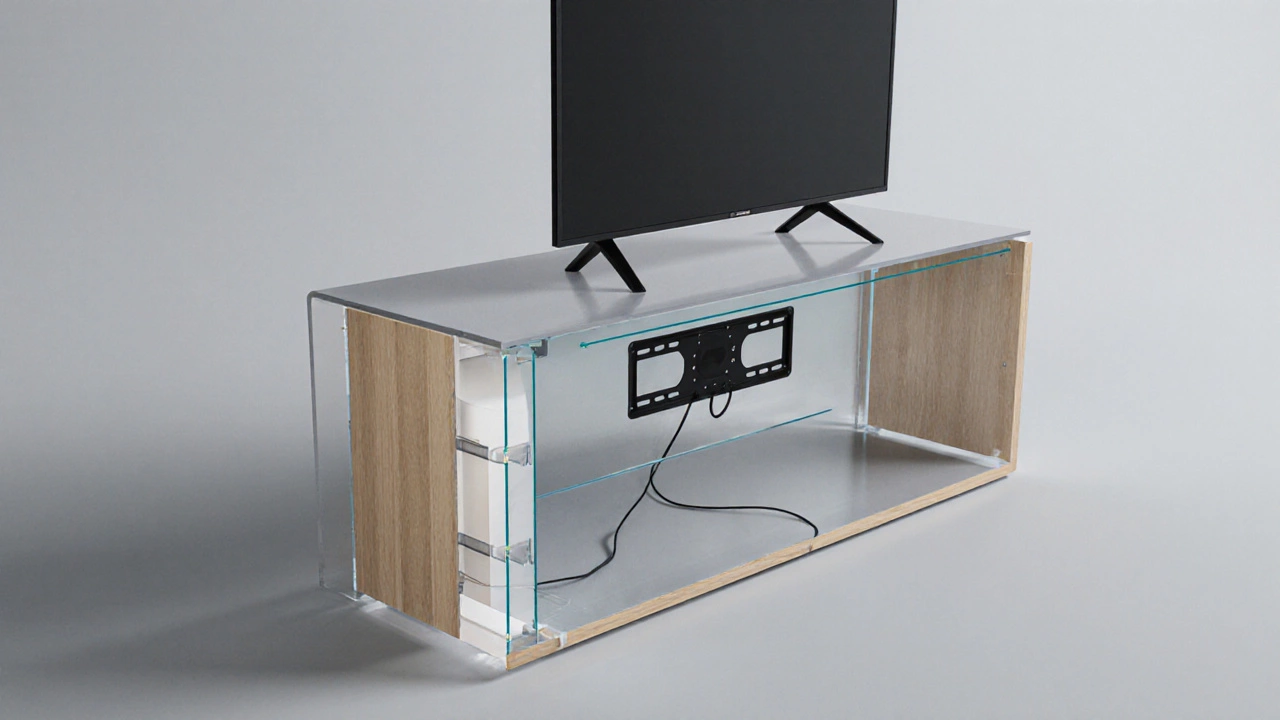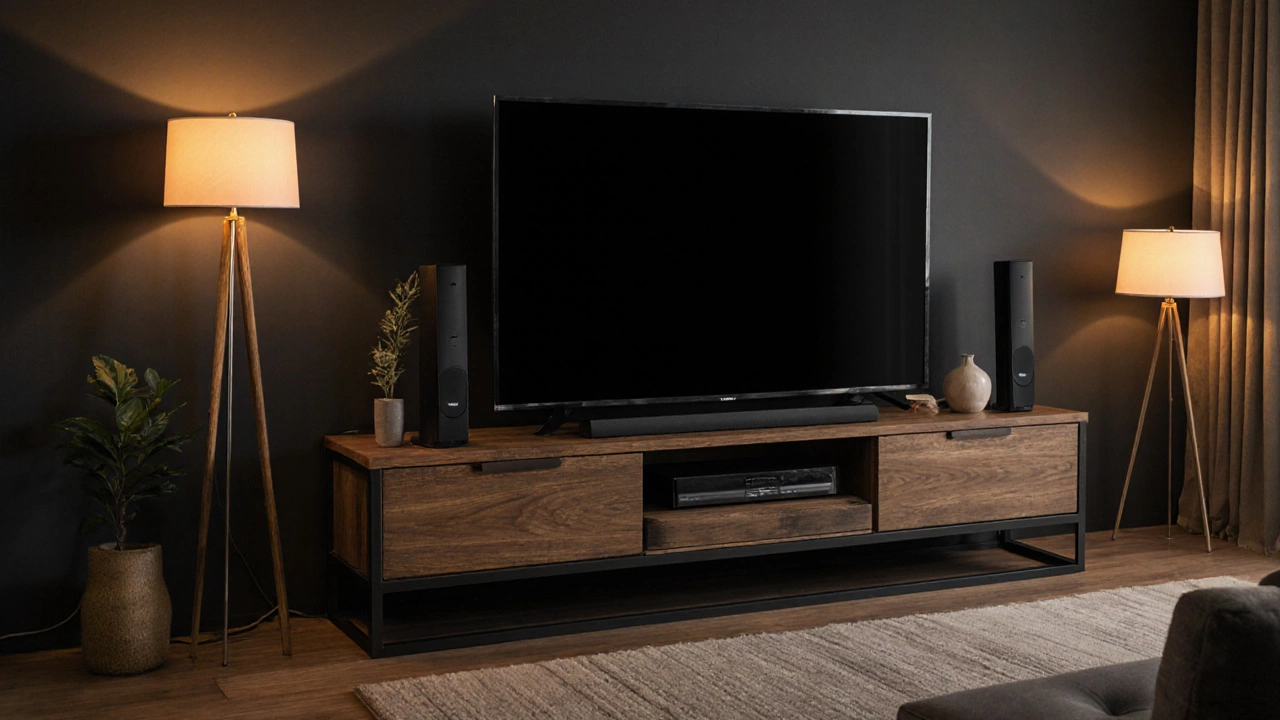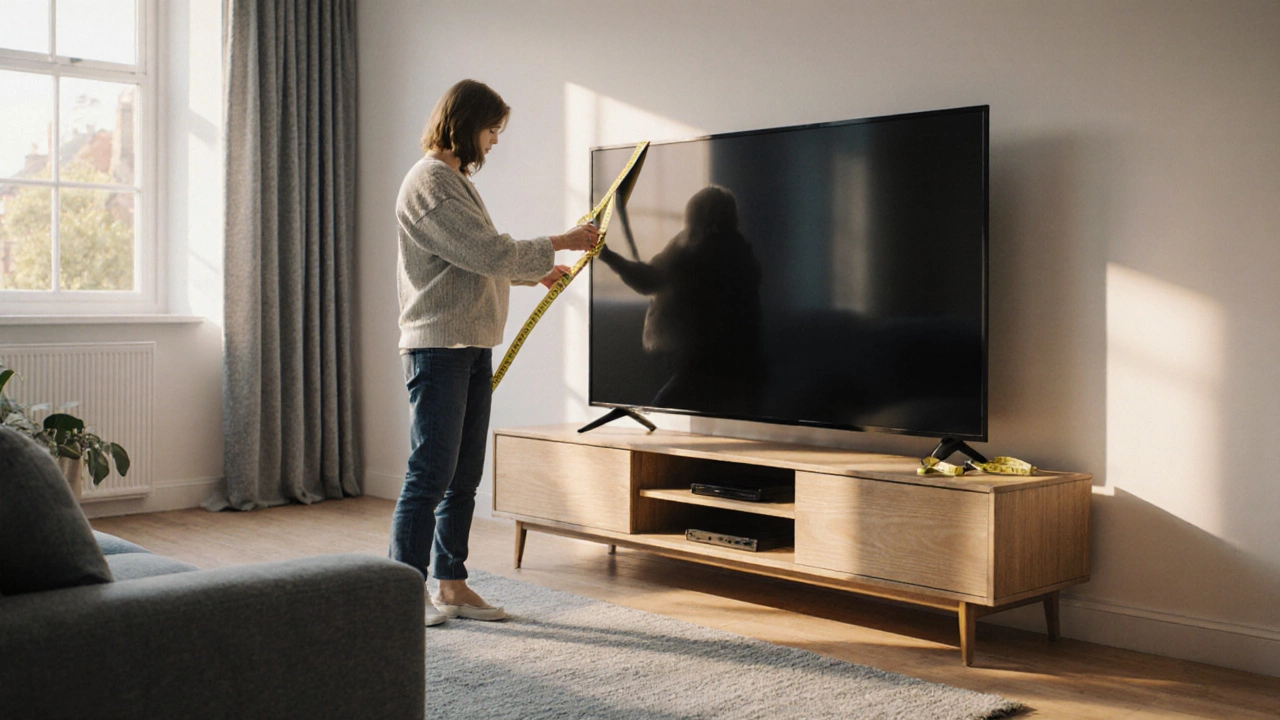TV Stand Size Calculator
Calculate the ideal stand dimensions for your 65-inch TV. Enter your TV's actual screen width and other preferences to get customized recommendations for width, depth, and height.
When you buy a 65‑inch TV is a large‑screen television with a diagonal measurement of 65 inches, typically featuring a 16:9 aspect ratio, the first thing you wonder is how big the TV stand should be. A well‑sized stand not only looks balanced but also keeps the TV safe and makes your living room feel tidy. Below is a step‑by‑step guide that shows you how to pick the perfect dimensions for a 65‑inch TV.
What the 65‑inch measurement really means
Most shoppers think the TV size is the width, but it’s actually the diagonal. For a 16:9 screen, you can calculate the true width and height with a simple formula:
- Convert the diagonal to centimeters (1 inch = 2.54 cm). 65 in × 2.54 = 165.1 cm.
- Use the aspect‑ratio ratio: width = diagonal ÷ √(1 + (9/16)²).
- Plug the numbers in: width ≈ 165.1 ÷ √(1 + 0.316) ≈ 165.1 ÷ 1.145 ≈ 144 cm (≈ 56.7 in).
The height works out to about 81 cm (≈ 31.9 in). Knowing the actual screen width helps you decide how much overhang you want on the stand.
Key measurements you need to consider
Three dimensions dominate the decision:
- Stand width - how far the tabletop stretches left‑to‑right.
- Stand depth - distance from the wall to the front edge.
- Stand height - the height of the tabletop from the floor.
Each of these interacts with the TV’s size, your viewing distance, and the stand’s load capacity.
How wide should the stand be?
The most common rule is to choose a stand at least as wide as the TV’s screen, but most designers recommend a little extra for visual stability.
- Minimum width = screen width (≈ 57 in for a 65‑inch TV).
- Ideal width = screen width × 1.2 - 1.3. That gives you a 68‑75 in range, which looks balanced and leaves room for side accessories.
Why the extra width? It reduces the perception of the TV ‘floating’ and provides space for speakers, décor, or a console beneath the TV.
Depth matters too - don’t forget the back
Depth isn’t just about aesthetics; it protects your TV from tipping. A good guideline is:
- Depth ≥ TV depth + 2 in. Most 65‑inch LED units are about 2‑3 in deep, so aim for at least 5‑6 in of tabletop depth.
- If you plan to mount the TV on a VESA mount that attaches to the stand, add another inch for the mounting bracket.
Deeper stands (8‑12 in) also give you room for cable‑management trays, which keep wires hidden and safe.

Choosing the right height
The eye‑level rule works well for most living rooms: the center of the screen should be about 42 in from the floor for a seated viewer whose eye height is roughly 38‑40 in.
To calculate:
- Measure your seated eye height.
- Half the TV’s height (≈ 16 in) and add it to the eye height.
- Result ≈ 54‑56 in total; subtract the leg height of the stand to get the tabletop height.
Most ready‑made TV stands sit between 20‑25 in high, which works for a 65‑inch TV on a standard sofa.
Weight capacity - don’t overload the furniture
A 65‑inch LED or OLED TV usually weighs 40‑70 lb (≈ 18‑32 kg). Look for a stand with a weight capacity of at least 100 lb (≈ 45 kg) to give you a safety margin.
Materials matter: solid wood and metal frames typically hold more than particleboard. If the stand lists “supports up to 150 lb”, you’re well covered for future upgrades.
Extra features that make life easier
Modern TV stands often include handy extras. Here are the most useful:
- Cable management - built‑in channels or holes that hide power and HDMI cords.
- Adjustable shelves or drawers for gaming consoles, Blu‑ray players, or a small soundbar.
- Open back or vented panels to improve airflow and prevent overheating.
- Integrated VESA mount - lets you attach the TV directly to the stand for a sleek look.
If you like a clean, minimalist vibe, choose a stand with hidden compartments and a low profile.

Quick reference table: Recommended stand widths for common TV sizes
| TV Size (inches) | Screen Width (inches) | Suggested Stand Width (inches) |
|---|---|---|
| 55 | 48 | 58‑65 |
| 65 | 57 | 68‑75 |
| 75 | 65 | 78‑85 |
| 85 | 74 | 88‑95 |
Buying checklist - what to look for before you purchase
- Measure the TV’s actual width (not just the diagonal).
- Confirm the stand’s width is at least 1.2‑1.3× the screen width.
- Check depth: TV depth + 2 in (or more if you need extra storage).
- Ensure the height puts the screen center near eye level for seated viewing.
- Verify the weight capacity exceeds the TV’s weight by at least 30%.
- Look for built‑in cable‑management solutions.
- Consider a VESA‑compatible mount if you want a sleek, wall‑like appearance.
- Read reviews for durability - solid wood, metal frames, and reinforced joints score higher.
With these points in mind, you can confidently pick a stand that fits your 65‑inch TV, matches your décor, and lasts for years.
Frequently Asked Questions
Do I need a stand that’s exactly the same width as my TV?
No. While the stand must be at least as wide as the screen, adding 10‑20% extra width creates a more balanced look and leaves space for speakers or décor.
What depth is safe for a 65‑inch TV?
Aim for a tabletop depth of 5‑6 in if the TV itself is only 2‑3 in deep. Deeper stands (8‑12 in) give extra room for cable trays and a sturdier base.
How high should the stand be for comfortable viewing?
The TV’s centre should line up with a seated eye‑level of about 42 in. Subtract half the TV’s height and the leg height of the stand to get the ideal tabletop height, usually 20‑25 in.
Can I mount a 65‑inch TV on a stand that also has a VESA bracket?
Yes, as long as the stand’s VESA pattern matches the TV’s mounting holes (commonly 400 × 400 mm for 65‑inch models) and the weight capacity covers the TV’s weight.
Is cable management really necessary?
It keeps your setup tidy, reduces tripping hazards, and makes future upgrades easier. Look for built‑in channels, grommets, or detachable trays.
With the right dimensions, a sturdy build, and a few practical features, your 65‑inch TV will look great and stay safe on its stand for years to come.


Write a comment